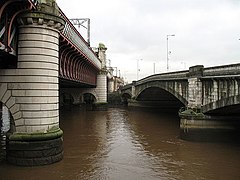Caledonian Railway Bridge
| Caledonian Railway Bridge | |
| Lanarkshire | |
|---|---|
 The Caledonian Railway Bridge (left) and George V Bridge (right) | |
| Location | |
| Carrying: | Railway |
| Crossing: | River Clyde |
| Location | |
| Structure | |
| Length: | 702 feet 6" |
| Material: | Steel |
| History | |
| Information | |
The Caledonian Railway Bridge carries the railway over the River Clyde in the middle of Glasgow. It reaches north across the river to the Broomielaw district of the city to bring the railway line to Glasgow Central station, which is close to the bridge.
First bridge

The first bridge here was built between 1876–1878 for the Caledonian Railway Company, and opened on 1 August 1879[1] It was engineered by Blyth and Cunningham and built by Sir William Arrol & Co.[1] It consisted of wrought iron lattice girders linked at the top by a light arched lattice girder, and carried on a cast iron arch over twin piers in the river.[1] The piers are formed of cast iron cylinders sunk to bedrock and filled with concrete, and then extended above the river with Dalbeattie granite.[1]
The approach span over Clyde Place to the south was 60 feet long, and over Broomielaw to the north of the river was 90 feet long.[1] The navigation spans were 164 feet, 184 feet and 152 feet long.[1] The bridge carried four tracks into the new Glasgow Central station.[2]
In 1966–1967, the girders and tracks were removed, leaving the pillars in the water, after resignalling meant it was no longer needed.[3]
Second bridge

The current, second bridge was built in 1899–1905 during the expansion of Central Station, to a design by D. A. Matheson, chief engineer of the Caledonian Railway, [3] Arrol and Co. was the contractor for this bridge as well.[3]
The foundations for the bridge are rectangular sunk caissons, sunk by the compressed air chamber method used on the Forth Bridge to a depth of up to 48 feet below the river bed.[3] The central span is 194 feet long with Linville truss girders 15 feet 9 inches deep.[3] The parapet girders are around 10 feet deep, and suspended on curved brackets.[3] There are a minimum of eight parallel main girders in the width.[3] The spans are of lengths 160 feet, 200 feet and 178 feet, and the structure contains 11,000 tons of steel.[3] The total length of the bridge between the abutments is 702 feet 6 inches.[4]
The bridge varies in width from 115 feet to 205 feet, and carries up to ten tracks.[3] It leads immediately into Glasgow Central Station on the north bank of the river. At the time of its opening, it was believed to be the widest railway bridge in existence.[4]
Outside links
| ("Wikimedia Commons" has material about Caledonian Railway Bridge) |
References
- ↑ 1.0 1.1 1.2 1.3 1.4 1.5 CANMORE (RCAHMS) record of Glasgow, Central Station, Old Approach Viaduct
- ↑ "1st Caledonian Railway Bridge". glasgow.gov.uk. http://www.glasgow.gov.uk/index.aspx?articleid=8394. Retrieved 11 September 2014.
- ↑ 3.0 3.1 3.2 3.3 3.4 3.5 3.6 3.7 3.8 "Glasgow, Central Station, New Approach Viaduct". rcahms.gov.uk. http://canmore.rcahms.gov.uk/en/site/79857/details/glasgow+central+station+new+approach+viaduct/. Retrieved 11 September 2014.
- ↑ 4.0 4.1 Matheson, D. A. (1910). "The New Clyde Bridge of the Caledonian Railway at Glasgow. (Including Appendix and Plates)". Minutes of the Proceedings 182 (1910): 4. doi:10.1680/imotp.1910.16924. https://zenodo.org/record/1449144/files/article.pdf.
| Bridges and crossings on the River Clyde | ||||||
|---|---|---|---|---|---|---|
| Kingston Bridge | Tradeston Bridge | George V Bridge | Caledonian Railway Bridge | Glasgow Bridge | South Portland Street Suspension Bridge | Victoria Bridge |
